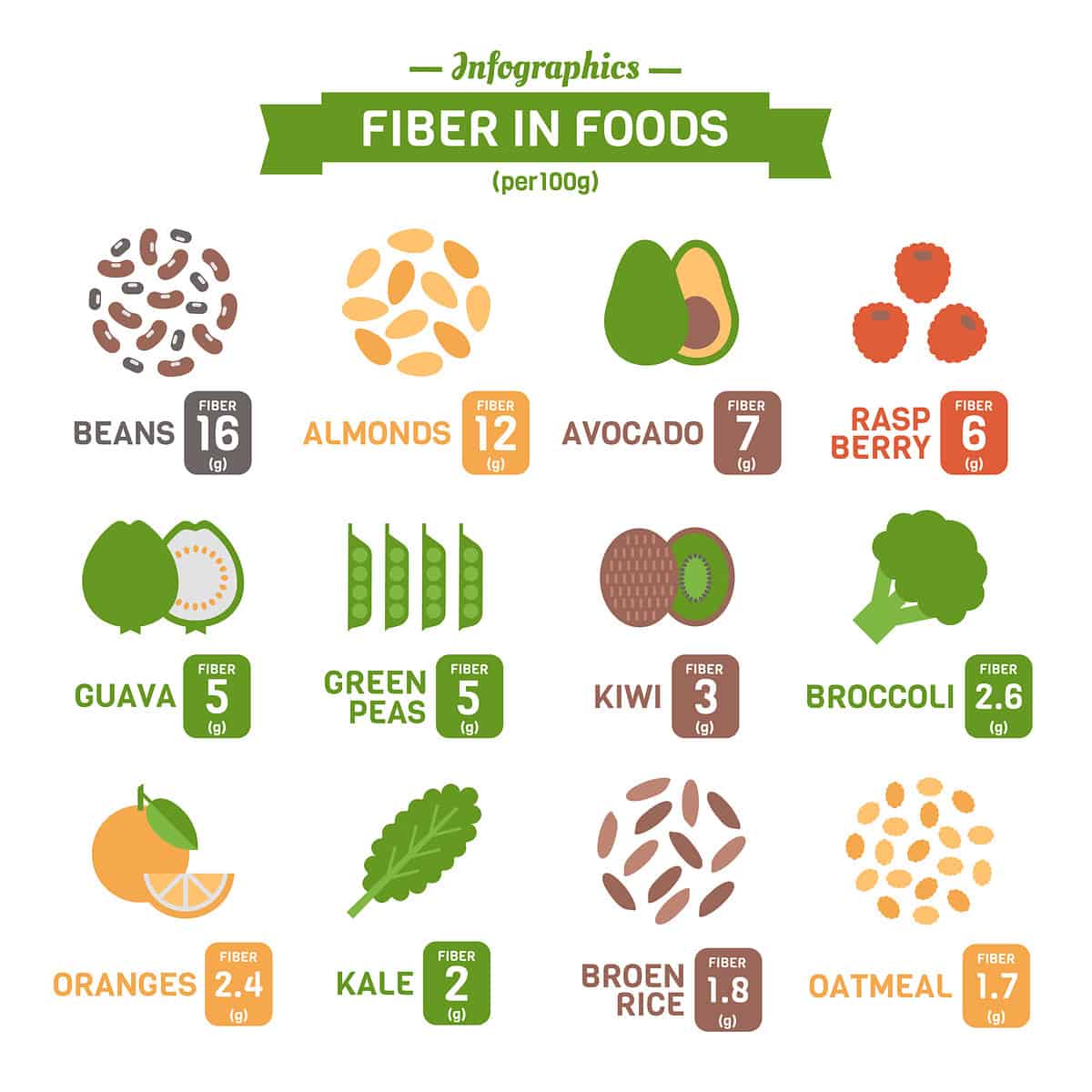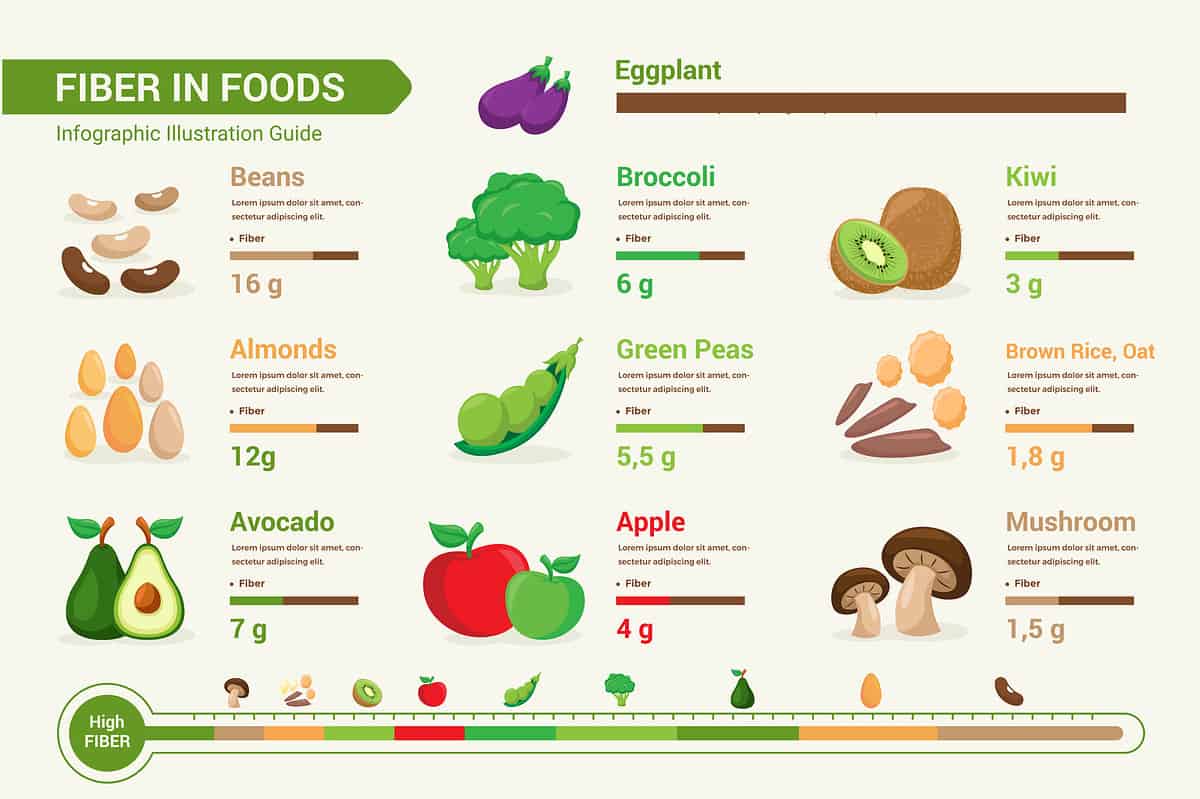

High-Fiber Foods Chart For Healthy Eating
It’s important that you and your children include fiber into your meals whenever possible because it’s a nutrient that’s essential for growing bodies and for preserving your health for the long term. As a mom, you may want to incorporate fiber into your family’s meals, but you may not know what foods and ingredients have the most fiber, and we’re here to help with a spectacular and free high-fiber foods chart for healthy eating.
This chart highlights some of the best foods with the highest fiber content that you can eat as a snack, or you can incorporate into a larger dish. When you're planning your next meal, look at this chart and think about which elements you can add for the most nutritious dish.

©Monkik/Shutterstock.com
What’s on the High-Fiber Foods Chart?
This particular high-fiber foods chart shows you the many different fruits, vegetables, snacks, and ingredients that you should incorporate into your dishes if you want to get the most fiber into your diet. Granted, this chart does not show every single food that has fiber in it, because many food items do, but it does show you the foods that have more fiber than others.
Fruit
You’ll notice that there are many fruits on this list, including raspberry, guava, kiwi, and oranges. These are all tasty fruits that will give you a major shot of fiber. When it comes to this chart, raspberry takes the lead. It’s worth mentioning that there are other fruits that are not on this chart but do contain fiber, including passion fruit, blackberries, pears, apples, and bananas, among others.
Vegetables
Your mother always told you to eat your vegetables, and it was for a good reason. This list has a few high-fiber vegetables, including green peas, kale, and broccoli. Other vegetables with a bit less fiber include carrots, eggplant, beetroot, cauliflower, and bitter gourd, among others.
Heavy Hitters
There are a couple of food items on this cart that offer a major dose of fiber, and they include beans and almonds. Beans contain the most fiber, and they’re extremely healthy for a number of other reasons as well. Beans are also rich in many vitamins and minerals, including protein, iron, potassium, zinc, and phosphorus. Have a side of beans for every meal, and you’ll be in good shape.
Almonds come in second on the list, which makes them the quintessential snack food. Eat almonds and just about any other form of nut when you get those hunger pains, and you’ll satisfy your appetite while also improving your overall health. In addition to the fiber they provide, nuts are also good for you because they also include essential nutrients, protein, and many vitamins. They’re a great snack if you’re looking to reduce your risk of heart and circulatory diseases.
Some of the other healthy nuts are:
- Walnuts - An excellent source of plant omega-3 fatty acids.
- Brazil Nuts - They contain selenium, which protects your cells and promotes thyroid health.
- Pistachios - They’re a great source of protein.
- Pili Nuts - Great source of magnesium, which regulates your blood pressure.
- Peanuts - Good source of vitamin B and other nutrients.
Why You Need Fiber
You’ve likely always heard that it’s important to have fiber in your diet, but do you know what it really does? Fiber is an essential nutrient for many important reasons.
Promotes Bowel Movements
They may not always be pleasant to think about, but it’s important to have regular bowel movements because this is how our body gets rid of waste. If you can’t go to the bathroom at all or you go too often, then it can be an issue. This is where fiber comes in. There are various types of fiber, including insoluble, soluble, and viscous, and they all play a role in your healthy stool. Whole grains in particular are great for promoting healthy bowel movements.
Keeps You Full
If you struggle with weight loss because you’re always hungry, then eating more fiber may be the answer. Fiber keeps you fuller for longer because it takes longer to digest, so you aren’t left with that empty feeling. If you want to go longer between meals then consider eating more of the foods on the high-fiber foods chart.
Lowers Blood Pressure
While research is still ongoing, many studies are showing that a diet rich in fiber can help to keep your blood pressure in a manageable spot. This is one of the most important things to keep an eye on. If your blood pressure is too high then you’ll have an increased risk of stroke and heart disease. Other ways to keep your blood pressure under control include exercising regularly, limiting your alcohol intake, and reducing the salt in your diet.
Keeps Your Cholesterol Levels in Check
Viscous fiber has a unique binding quality that traps excess bile and cholesterol in your GI tract. This is important because keeping your cholesterol in check is necessary for heart health. Fiber can also help to reduce LDL cholesterol levels, which is a dangerous type that can clog your blood vessels.
Reduce the Risk of Severe Diseases
Fiber is important for many reasons, and most important is that regular fiber intake has been found to help reduce the chances of many severe diseases, including type 2 diabetes, heart disease, and colorectal cancer. There are numerous reasons for why this is so, but the point is that you need to add fiber into your diet for the good of your health and the health of your kids.
How Much Fiber Do You Need?

©naulicrea/Shutterstock.com
It’s important that you and your kids get the recommended dose of fiber so you can live healthy lives and avoid those dangerous diseases. The American Heart Association recommends that everyone in the family consumes at least 25-30 grams of fiber daily. They recommend that you try to get that fiber from your food and not from supplements. To put things into perspective, currently most people consume 15 grams of protein daily, so you likely need to increase your intake.
Fiber-Rich Recipes
Here at Momswhothink.com, we have a great library of healthy and tasty recipes, and many of them include ingredients that are high in fiber. If you’re looking for something to make for dinner tonight, then consider some of these options:
Recipes That Include Broccoli
- Broccoli Shrimp with Orzo - Shrimp and broccoli are an unforgettable combination.
- Broccoli Chicken Noodle Bake - A great dish that will provide at least one good meal.
- Chicken and Broccoli Braid - Includes red pepper and other healthy ingredients.
- Broccoli Chicken Stir Fry - A classic stir fry that’s rich in fiber.
- Broccoli-Lovers Lasagna - Tasty pasta that’s loaded with fiber goodness.
Recipes That Include Beans
- Ditalini Pasta with Black Beans, Tomatoes, and Cheese - Black beans are rich in fiber.
- Green Beans and Pecan Salad - A simple but delicious salad.
- Baked Beans with Ham - Baked beans offer a different flavor, but they still contain fiber.
- Sweet Beans and Noodles - Linguine pasta and fiber equals the perfect meal.
- Mexican Pizza with Refried Beans and Cheddar Recipe - Pizza can have fiber too!
Eggplant-Rich Recipes
- Penne with Italian Eggplant and Mushroom Sauce - This pasta is tasty, and eggplant is a great source of fiber.
- Manchego Italian Eggplant - This is a twist on eggplant and fiber is included!
- Eggplant and Tomato Sauce with Pasta - A simple pasta recipe, but it will provide a healthy dose of fiber.
Conclusion
This is all you need to know about this high-fiber foods chart. It’s essential that you incorporate fiber when possible so you can feel better and avoid the chances of severe health issues. Teach your kids the importance of fiber now, and they can learn the secret to a long and happy life.